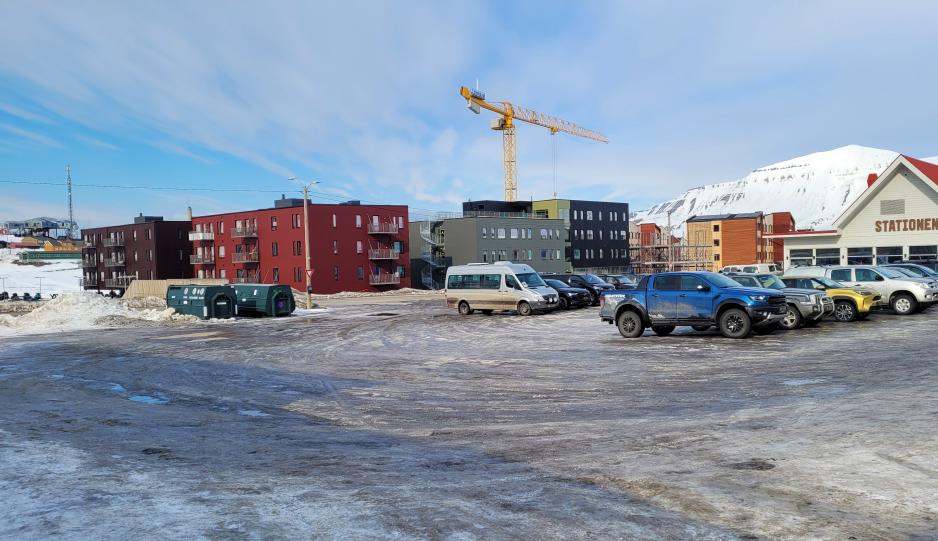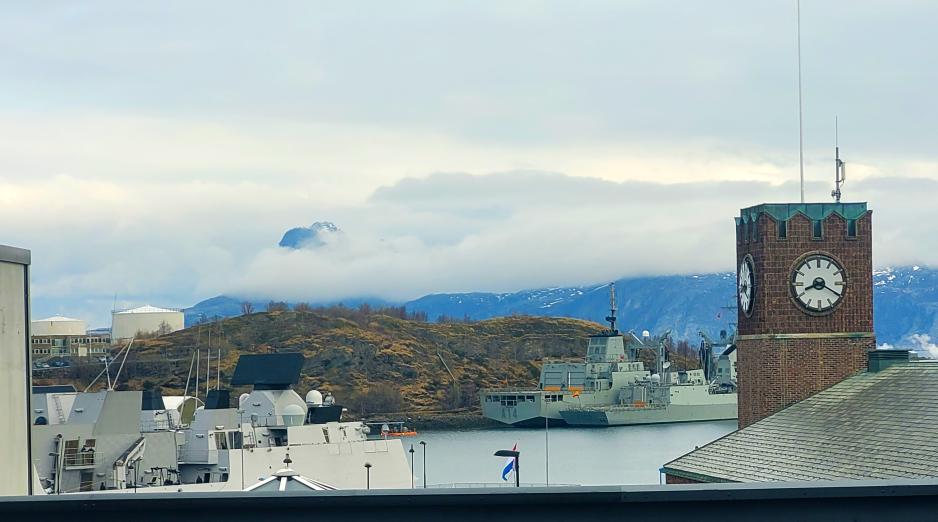Arne O. Holm says High North Security in the Real Arctic

The sea and the mighty mountains are closed off by increasing large housing blocks. (Photo: Arne O. Holm)
Longyearbyen (High North News): Longyearbyen does not look like itself anymore. The city is barely recognizable, even to itself. And that does not only apply to architecture.
Coincidence led me to read the Norwegian Expert Commission on Norwegian Security and Defence Policy report while located in precisely Longyearbyen. At 78 degrees north, I detect a solemn commission leader, Knut Storberget, who hands over the commission's conclusions and analyses to the Norwegian MoD.
Little to smile about
Bjørn Arild Gram gives thanks. There is little to smile about in a document in which the way to insight is through a document permeated by military threats. The message is both gloomy and costly.
Gloomy because we as readers, through 364 packed pages, are being prepared for a potential war. Costly because the commission believes the current defense cannot handle such a crisis.
I lift my coffee cup and peer out the window in search of a view that has provided energy and peace for decades. I search in vain. The view is gone. The beautiful Isfjorden and the mighty mountains painted white that surround Longyearbyen have been replaced by massive housing blocks.
The city has been prepared for a new era and the explanation can be found in the defense commission's new report.
Longyearbyen does not recognize itself.
Stunned by the war
It started on the 17th of December 2021, when the commission was tasked with "considering Norway's security policy challenges". The members had hardly started their work when Russia attacked Ukraine two months later.
The Russian warfare was of course decisive for the commission's work and decisive for a conclusion that will cost us a state cash outlay of NOK 30 billion, and then an extra NOK 40 billion a year for the next ten years.
That is how military preparedness is priced out of step with reality, as it is perceived by a defense commission.
I read the report while in Longyearbyen, a city that has been drawn further and further into Norwegian security policy in the last year. Svalbard has always represented security policy, but now it revolves around security policy above all.
In January this year, the government announced that there was a need for a new Svalbard White Paper. The directive was different than for other white papers. This time, the government had added security as part of its reasoning. It had never been emphasized so clearly before.

The military activity in the High North dominates the view in Bodø as well. (Photo: Arne O. Holm)
A lot about Svalbard
The message from the defense commission earlier this week beats the white paper to it in some areas. Svalbard takes up a lot of space in the report.
There are several reasons for that.
Among other things, this is about energy supply to Europe, in which Svalbard's location is of great significance for surveillance and defense.
Furthermore, this is about climate change which in turn reinforces the significance of every Arctic island. The commission especially emphasizes Russian interests in the Arctic and Svalbard's military strategic significance to Russia.
The archipelago is also crucial for satellite surveillance and access to ice-free ports. In addition, the battle for resources in northern areas can trigger a conflict.
This is about an archipelago in which Russia has a solid footing through its presence in Barentsburg, about 60 kilometers from the Norwegian settlement in Longyearbyen.
Disconnecting
At one point, it could look like the defense commission is disconnecting from those who currently are hard at work with the Svalbard White Paper. The latter has a clearly stated aim of not only slowing down but maybe even reducing the population in Longyearbyen. The defense commission emphasizes the contrary.
In its report, the population of Eastern Finnmark and Longyearbyen are mentioned in the same section, as a resource to reduce the risk of a Russian invasion.
The view is gone, but so is the economic horizon.
"Norwegian settlement and economic activity also hold special value on Svalbard, which does not have military bases or permanent military presence," the report states, which adds that "increased activity in the High North may lead to increased interest in economic exploitation on Svalbard."
I am not sure whether the final sentence refers to Norwegian or international interests. The first points to Norwegians alone.
And it is precisely here that the existing business sector in Longyearbyen, which today has an annual turnover of about NOK 1 billion, does not recognize its own city.
The view is gone, but so is the economic horizon. Because how are we to secure a robust Norwegian population, when the national authorities announce that growth is to be slowed down?
Reduced activity
And with the same backdrop: How is Norway going to step into the breach for new business development on Svalbard, if the government aims to reduce the overall activity on Svalbard?
The Svalbad White Paper, scheduled for 2024, must provide good answers to this.
In sum, it is far from surprising that the defense commission spends a lot of its time analyzing the military strategic challenges in precisely the High North.
The other day, Denmark also announced, somewhat surprisingly, that their most important military strategic area is in the north. "First comes the Arctic and the Kingdom of Denmark, then the Baltic Sea and Denmark's immediate areas," said the Danish MoD Troels Lund Poulsen.
It is not just the view from Longyearbyen that has rapidly changed.
Back in Bodø, I cannot spot the familiar mountain formations where the sea ends either. Today, during my morning coffee, I looked straight into heavily armed, international warships on their way to new military exercises in the High North.
Also read
This commentary was originally published in Norwegian and has been translated by Birgitte Annie Molid Martinussen.


